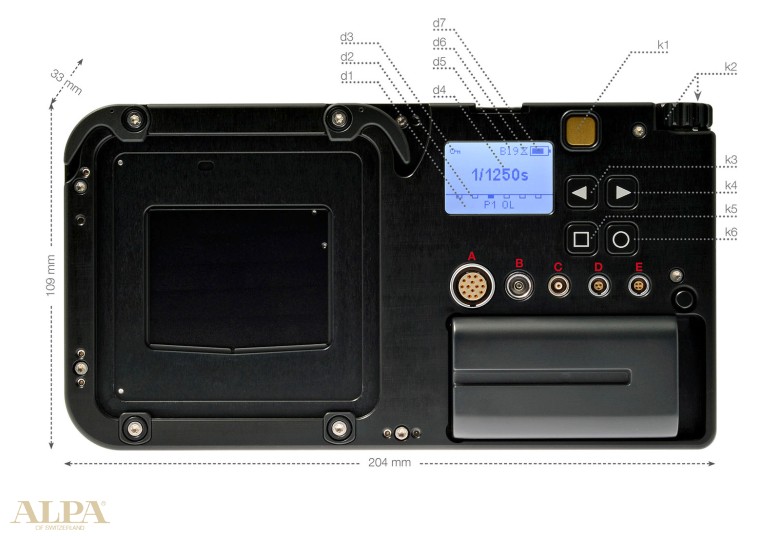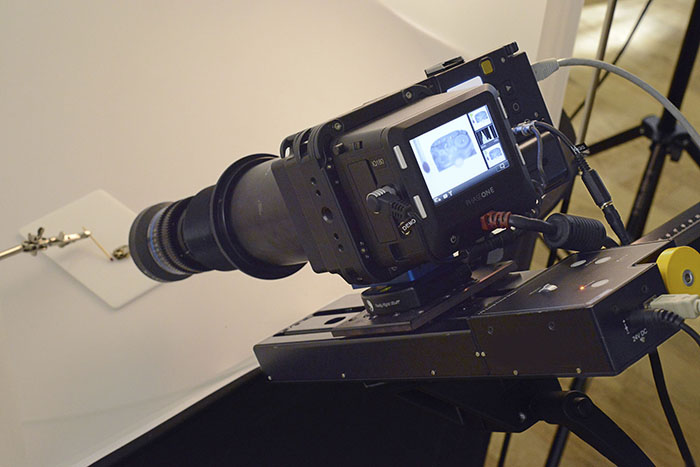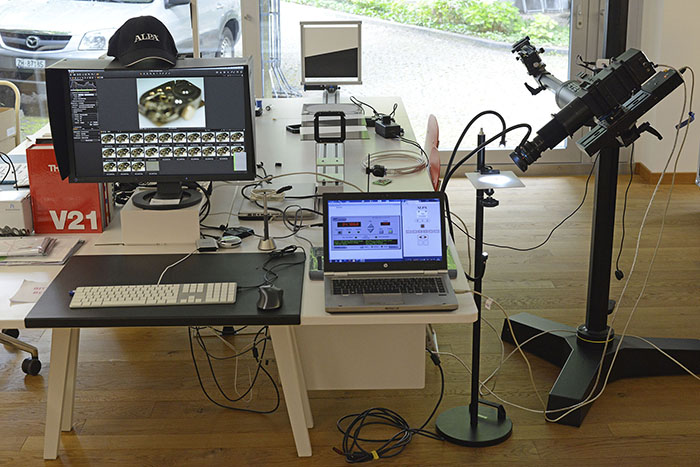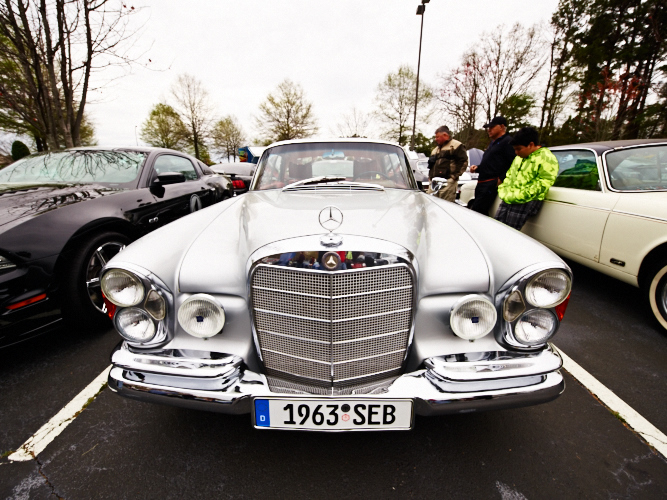Top 10 Features of the ALPA 12 FPS

1. Design and usability
The ALPA 12 FPS is distinguished by a clearly laid out and easily accessible keypad, which, together with the rotary knob that can be clicked, makes it possible to adjust the camera rapidly. More infrequently used menu items (such as setting up the network parameters) have been relegated to a dedicated “configuration” sub-menu, so as to keep the user interface lean and well arranged. With ALPA, you will find intuitive controls and adjustment wheels dispersed over the entire camera, and you will also not come across any fiddly switches or buttons.

The bright, trans-reflective display makes the settings easy to read, even in extremely bright environments. Undesired reflex lighting of the display lighting (which can also be switched off entirely) is reliably prevented through an automatic “dark phase” during exposure.
The well-thought out concept is continued in the camera’s shutter release: The release, designed in a gold color (to match the gold-colored release on the ALPA lenses) is located on the back of the camera so that it is easily accessible for the user’s thumb. Fixing it in this position makes it possible to release the shutter with considerably less “tilting” of the camera.
Not only for these reasons, but also due to its sustainability and modularity, the ALPA 12 FPS has already been distinguished for its brilliant design with the RADO Product Award within the scope of the SWISS DESIGN awards.
2. Extreme modularity
In spite of its very smooth and tidy design, the ALPA 12 FPS comes with a V-shaped or 3/8″ thread on each of its four narrow sides, to which various accessories can be attached: Along with the obligatory quick release plates for tripods are also various handles for the right and left-hand sides, which can be extended with inserts for both mechanical and electronic release.

Take your pick: you can choose high-precision spirit levels, as well as spacers and optical viewfinders, from the extensive range of ALPA accessories.
3. Endurance
Staying true to the motto “We are Toolmakers”, the ALPA 12 FPS was developed as a tool for extensive photographic tasks. This claim is already expressed in the decision to do away with a traditional closed battery compartment alone, and instead to construct a contact plate that is open to the rear, which takes “standard Sony video batteries”. In fact, with most application scenarios, the standard size (2600 mAh) is in fact sufficient, however twofold (4400 mAh) and even threefold (6600 mAh) capacity models are available for special applications (e.g. gigapixel panoramic views with several thousand releases), giving the ALPA 12 FPS the freedom of many hours’ battery power for when there is no power point in sight. “At home” in the studio, the ALPA 12 FPS can, of course, also be supplied via a separately available mains adapter, which can be securely connected via a locked “LEMO” plug.

It is not only the power supply of the ALPA 12 FPS that is conceived to provide the greatest endurance; the assembly of the shutter and its cocking by means of a “Faulhaber” motor has also been optimized with a view to lasting a long time. This predestines the ALPA 12 FPS to be the perfect platform for copy work tasks, with several hundred or even a thousand photos daily, or for focus stacking or gigapixel panoramas.
4. Upgradeability
Besides the durability, the extensibility was also at the top of the list of technical specifications to achieve when developing the ALPA 12 FPS. Software updates can be installed in an effortless way via the integrated USB interface (by means of the memory card supplied along with the camera, or a broad selection from among of the flash drives readily available on the market). Numerous integrated safety mechanisms ensure that, even when there are problems with the update (corrupted downloads, insufficient power supply), it can virtually be entirely excluded that the camera will fail to function.

Another highlight is the XML-compatible “ALPA SYNC LANGUAGE”, which not only permits the “triggering” of even rare (future) back types, but simultaneously makes it possible to extend the ALPA FPS by special modes, e.g. for controlling the flash (multiple flash, flash on the 2nd shutter curtain, multiple exposure, etc.).

5. The remote control
Special photographic situations necessitate special solutions. It is not only when used in architectural and industrial photography that spectacular perspectives and at the same time challenging locations for photography increasingly need to be administered; even studio stills of large objects (whether it be cars or furniture) often require raised positions. The ALPA 12 FPS is well suited for this, as it can be perfectly operated via remote control. The latter does not solely concern remote operation of the shutter release, but rather all electronically controlled parameters involved with taking a picture can be accessed and changed in the user’s web browser via a user interface identically modeled after the one found in the camera. The content of the display is also simultaneously transmitted in its entirety, and reproduced in the browser window.

The implementation of this remote control (protected by a Swiss patent) permits the user to access the ALPA 12 FPS user interface using a tremendous number of different devices (such as smartphones, tablets, desktop PCs). In that respect, the technical implementation with a web server working on the camera offers quite a number of benefits: For example, no special software or driver is required on any of the devices, but a standard web browser (preferably Chrome or FireFox) is sufficient to communicate with the camera. That means the inconvenient and time-consuming updates of client software also do not need to be carried out, because all the functions implemented in the ALPA 12 FPS firmware are also available in the network. Simultaneously, it is possible not only to access multiple cameras from one device when you have special requirements, but also to access one camera from multiple devices.
As a particular treat, many AF lenses (e.g. Canon EOS, Contax 645, Hasselblad H, and in future also Rollei AF) can be focused in fine and wide increments by remote control, in regard to which feedback concerning the distance set is shown on the display (depending upon the type of lens). In particular photographers who work, for example, in the automotive field, using a tall tripod, appreciate this feature, designated “CF” by ALPA (“Controlled Focus”).
6. Usability for macro and repro photography
Due to the sum of its above-mentioned properties, the ALPA 12 FPS is likewise predestined to be both a platform for “copy work” and also to be used for sophisticated applications that are on the verge between macrophotography and microphotography. Precisely in these fields of application, you benefit from its enormously durable and especially vibration-free shutter (see also Point 10) and the many different flash synchronization modes that open up numerous different lighting options for the user (with flash light and continuous light). The power supply, which is both modular and high-performance, provides a guarantee of work free of any interruption. Due to the comfortable and extensive remote controllability, all functions can also without any problem be operated high up on reprostands, and vibrations due to manual intervention are reliably avoided. For all these reasons, ALPA has decided to continually extend the range of accessories in the macro field. Besides the traditional lenses from the company Rodenstock (such as the proven and tested Helvetar 120mm), ALPA enables the use of special industrial optics for the high close-up range (up to 5 to 1, i.e. five times life size), and offer “custom-made solutions” for focus stacking by means of automated shifting of the camera, synchronized to the release of the shutter.


Ask us! We will be happy to collaborate with you in formulating solutions adapted to your needs!
7. Extreme wide angles
By deliberately refraining from using an instant-return mirror (which some obsolete in the age of CMOS sensors), a focal length that is sensationally small for a medium format camera ¬ could be implemented with the ALPA FPS. This enables not only adaptation to numerous different medium format lenses (see next point), but also the use of small image lenses with Nikon F or Canon EOS bayonet mount. Many other types of connection can be adapted with “third party adapters” via Canon EOS, i.e. Olympus or Leica, for example. Check out the CI post that discusses using the FPS with Canon wide angles.
Particularly interesting in regard to the use of the medium format backs, in that respect, are the (tilt and) shift lenses for small image format, as they mostly offer an image circle which (when not shifted) covers the entire image area of the medium format sensors. In this way, photographers coming from the world of small image photography are offered the option of an incremental and cost-effective ascent into the medium format league.

In that regard, a particular advantage is offered by the Canon TS-E 17mm f/4L tilt-shift lens, which offers the greatest possible angle of vision in the medium format range: On a 40 x 54 mm sensor (such as the IQ260/280 or Credo 60/80) it corresponds to approx. 11mm focal length, on a sensor that is 33 x 44 mm in size still a focal length for compact cameras of 14 mm. The latter opens up previously unheard of room for maneuver, precisely in capturing the interiors of buildings and cars, but also entirely new opportunities for making creative photos.
8. Sustainability
Investments in ALPA have, since time immemorial, been stable investments – hasty changes in the model have never been the order of the day among the Swiss “toolmakers”, and the two prime ALPA models (the 12 SWA and the 12 WA) are still being manufactured these days and are enjoying great popularity, precisely among analogue photographers. The ALPA 12 FPS also assists you in protecting your investments in the long term, and not only continuing to use your familiar lenses and digital camera backs, but also the previously unknown freedom to combine them in accordance with your own requirements.
On the reverse side of the camera, five different connections for digital backs can be used on the FPS via the alternating adapter system that has been tried and tested a hundred times over many years, which also allows for individual adjustment of the focal length (“shimming”): Besides Mamiya/Phase One 645 and the two very widespread “standards” of the Hasselblad H and V system, adapters for backs with Contax 645 and Leaf/Rollei Hy6 connections are also available.

Also with the lenses, a variety of equipment is available, which, as per our knowledge, cannot be used as comprehensively as with this camera with any other system. In addition to the adaptors for Nikon F and Canon EOS (and the further adaptations for 35 mm lenses that are possible with these) already mentioned above, there are also adaptors for MAMIYA 645 (Manual Focus) and Hasselblad V.
On the occasion of Photokina 2014, another two adaptors for Hasselblad H and Contax 645 lenses were presented, and another one for Rollei 6xxx is in the pipeline. Common to all three is that they offer full electronic control over the f-stop and motorized focusing (Contax 645, Hasselblad H and Rollei 6xxx to the extent available in the lens), and also the diaphragm shutter (Rollei 6xxxx and Hasselblad H). Respective “fixed” and shiftable adaptors are available for all three adaptors.

In that respect, the ALPA 12 FPS can naturally not only be used with third party lenses, but also with the seven extremely high-resolution lenses of Rodenstock in FPS-SB 17mm mount (32mm, 40mm, 70mm) and SB-34 mount (90mm 100mm, 180mm) and six outstanding lenses of Schneider Kreuznach in SB-17 FPS (60 and 75mm) and SB-34 (90mm, 120mm, 150mm, 180mm) directly available from ALPA. This large number of options is also particularly helpful to photographers who wish to achieve special creative effects (such as through the use of Petzval lenses or old hardened and tempered metal constructions), but also to professionals who would like to implement complete series of photos with quite different lenses, using color to create a uniform appearance, in the case of extensive projects, which is naturally simplified significantly through working with a single back.
9. Shift Modules
The ALPA 12 FPS is, however, by a long chalk, not only an outstanding “stand-alone camera”, but also a valuable extension of the existing ALPA system. Thus, the ALPA 12 FPS may also serve as a “shutter module” for existing ALPA cameras, which then, combined with SB-34 lenses (50mm, 90mm, 120mm, 150mm and 180mm) take on the function of a “shift module” (e.g. with the ALPA 12 SWA, STC, MAX and XY). These lenses can alternatively also be used in combination with the 17mm tilt/swing FPS adaptor for extending the sharpness in accordance with the Scheimpflug technique.

Adjustments of perspective and shifting the focal plane can also be carried out with “third party lenses”: Thus, the new adaptors for Hasselblad H, Contax 645 and the adaptor currently being developed for Rollei 6xxx are each available in shiftable designs (+/- 12mm horizontally and +/-12mm vertically), but the tilt and shift can even be combined (the tilt to 5° and the shift via an ALPA camera) with the adaptor for Hasselblad V lenses.
The special attraction of a technical camera such as the ALPA 12 FPS is precisely in such diverse adjustment options combined with the greatest degree of mechanical precision.
10. The FPS focal plane shutter
The “ALPA 12 FPS” not only derives its name from the “focal plane shutter”, but it is simultaneously also one of its most convincing details. Its assembly position permits a procedure with very little vibration, and the fully electronic timing is another asset for the aspiring photographer. The rapid 1/4000 sec exposure not only makes it possible to take photographs in very bright environments, but also to “freeze” fast movements (whether it be of the motif or the camera (platform), such as in aerial photography). However, not only short times are possible; long exposures (of up to 128 secs) can be implemented as well.

This diversity, the fine gradation (of 1/4 EV) and its enormous reliability make the focal plane shutter a feature of the camera that greatly facilitates the many different photographic tasks (such as the preparation of an LCC shot), and, due to its rapid motorized mount, the ALPA 12 FPS is moreover also predestined for special applications such as focus stacking, gigapixel panoramas and (HDR) exposure series.

And, should the comparatively short flash synchronisation speed of 1/125 not be sufficient, the leaf shutter integrated with the lens can also be used in the many cases when COPAL 0, Hasselblad H and Rollei 6xxxx are used, to implement short flash synchronization speeds (of 1/500 sec. and less). In the case of Rollei 6xxx and Hasselblad H the timing is controlled electronically by the ALPA 12 FPS.
Thus, the ALPA 12 FPS once again appeals to the ambitious photographer, who would like to take an independent decision about the type of shutter suitable, and simultaneously overcome the previous “dependence” of many existing “tech cams” on the mechanical COPAL-0 lenses. Precisely in connection with the new CMOS-based digital backs with their fantastic live view, the ALPA 12 FPS is thus becoming a solution at the interface between technical cameras and mirror-less system cameras.
The ALPA 12 FPS is available for sale and rental through Capture Integration. Contact our representatives to learn more about this impressive system today.



